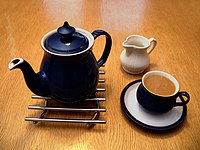
Photo from wikipedia
The market value of distilled beverage relies on its quality with a major contribution of distinctive and fascinating aromas. The aroma of distilled beverage is built on the basis of… Click to show full abstract
The market value of distilled beverage relies on its quality with a major contribution of distinctive and fascinating aromas. The aroma of distilled beverage is built on the basis of chemical components and can be modified through a series of physical and chemical processes such as aging. Revealing the hidden knowledge behind the evolution of numerous chemical components during these physicochemical processes in distilled beverages is not only significant but also challenging due to its complex system. In this review, the trends in the changes of associated aroma compounds over aging are proposed on the basis of understanding the relationship between chemical components and aroma profiles of numerous typical distilled beverages. The different aging systems, both classical platforms from Eastern countries (pottery jars) to Western countries (wood barrels), and modern platforms such as artificial aging technologies are outlined and compared with their respective applications. Optimizing aging processes is a challenging but imperative step, which warrants further fundamental knowledge from targeting aging-related molecules to the exploration of multitude physicochemical reaction mechanisms that occur during this process, such as the formation of potent odorant compounds in specific containers and environments, as well as mass transfer processes between solid and liquid interfaces. Understanding these maturation mechanisms of distilled beverages expressed by chemosensory signature holds promise for major improvements in future aging technologies that can efficiently yield stable and high-quality products.
Journal Title: Comprehensive reviews in food science and food safety
Year Published: 2022
Link to full text (if available)
Share on Social Media: Sign Up to like & get
recommendations!